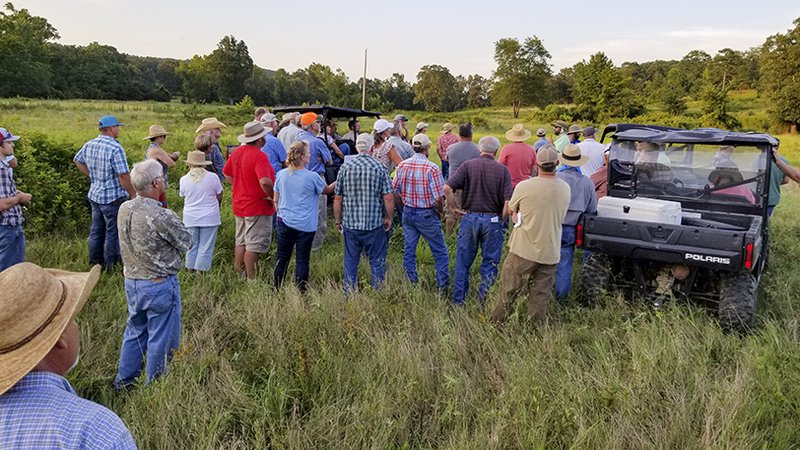Landowner meetings clear way for wildlife habitat enhancement
ON 08-14-2019

Aug. 14, 2019
Randy Zellers
Assistant Chief of Communications
EL DORADO — Landowners and representatives from timber companies, non-profit organizations and state agencies representing more than 1.1 million acres of private land in southern Arkansas collaborated during June workshops in Hope and El Dorado to improve habitat for turkey, quail and other wildlife in Arkansas.
The workshops are part of the Arkansas Game and Fish Commission’s ongoing effort to work with private landowners throughout the state to help manage wildlife across the entire landscape.
According to Luke Lewis, assistant chief of the AGFC’s Wildlife Management Division, this cooperation from private landowners is essential.
“Close to 90 percent of Arkansas is in private ownership,” Lewis said. “If we’re going to do things for quail, turkeys, pollinators and our deer programs as we look at issues like CWD, it’s got to be done with some of these small private landowners being a part of the effort.”
Thanks to the help of Commissioner J.D. Neeley, owner of Neeley Forestry Services, the meetings were coordinated with the help of local forestry consultants and each meeting had more than 100 people in attendance.
“It was kind of an ‘Aha! moment’ for us, realizing how many private landowners forestry consultants touch and how many depend on them to make sound management decisions,” said Lewis. “Several large consulting companies helped sponsor the meals and location and helped us develop a list of contacts to invite to the workshops.”
Each workshop had three primary goals: to educate landowners about the needs of wildlife, to help landowners develop and implement plans to create better wildlife habitat, and to empower participants with the contact information they need to get the work done with as little expense as possible.
Lewis said, “When a person left each workshop, we wanted them to have the answers to these three questions: Do you have a plan to improve wildlife habitat on your property? Do you know about the programs and options available to help pay for any expenses to implement your plan? Do you know how to get in touch with contractors to do the larger parts of the work like prescribed fire, mulching and thinning you may not be equipped to handle on your own?”
The last of those questions can sometimes be the biggest barrier for many small landowners. The willingness to improve wildlife habitat is strong with many people, but knowing where to get started can be daunting. When getting started means the use of heavy equipment, it can be extremely intimidating.
“That’s where the help of forestry consultants really plays a key role,” Lewis said. “Managing private land to enhance wildlife habitat is what they excel at, so they are the perfect tool to reaching these landowners’ goals.”
Jeremy Wood, turkey program coordinator for the AGFC, says the workshops were also a great way to build relationships with many people who can help the conservation effort through some of the agency’s new initiatives.
“In the last year, we’ve really ramped up our ability to collect information from the public to help get a better picture of turkey and quail reproductive success, harvest and habitat needs,” Wood said. “We have a relatively small staff of biologists to conduct scientific monitoring programs, but we can build upon their observations by establishing new contacts and working with the people who are on the ground all year.”
Wood says the participation from private landowners was very encouraging and similar landowner workshops will be planned for 2020 in other parts of the state. As new workshop opportunities are developed, they will be posted to the AGFC’s website and Facebook page, and more landowners will again be contacted individually through contacts with some of the AGFC’s partners such as the National Wild Turkey Federation, Quail Forever, The Natural Resources Conservation Service, timber companies and forestry consultants.
“We really want to spread this message across many parts of the state and be able to customize the presentation based on the habitat types and land use challenges landowners may face on a local level,” Wood said.
Landowners looking to improve wildlife habitat on their land don’t have to wait for a workshop, though. The AGFC has a team of biologists dedicated to helping landowners achieve their goals by writing customized habitat plans based on the soils, current land use and habitat types of their property. They can even identify possible government assistance programs to help offset any costs of improving the habitat value for wildlife.
Sponsors of the workshops included Kingwood Forestry Services, Red River Specialties, Stevens Forestry Service, Inc., Neill Forestry Consultants, Neeley Forestry Service, ChemAir, United Country Real Estate and Emon Mahony.
Recent News
Subscribe to Our Weekly Newsletter E-mails
Don’t miss another issue. Sign up now to receive the AGFC Wildlife Weekly Newsletter in your mailbox every Wednesday afternoon (Waterfowl Reports are published weekly during waterfowl season and periodically outside the season). Fishing Reports arrive on Thursdays. Fill in the following fields and hit submit. Thanks, and welcome!


